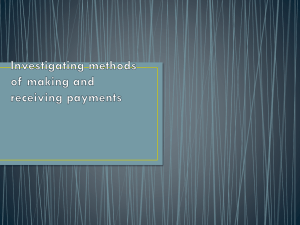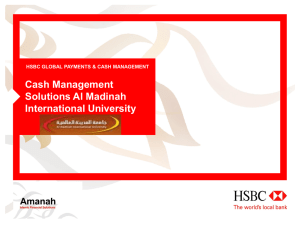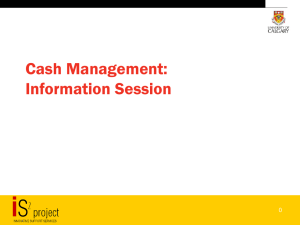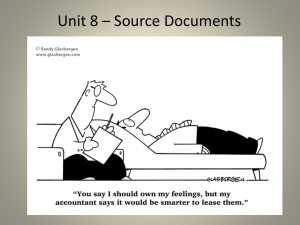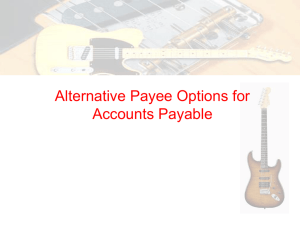A Future with E-cheques - The Hong Kong General Chamber of
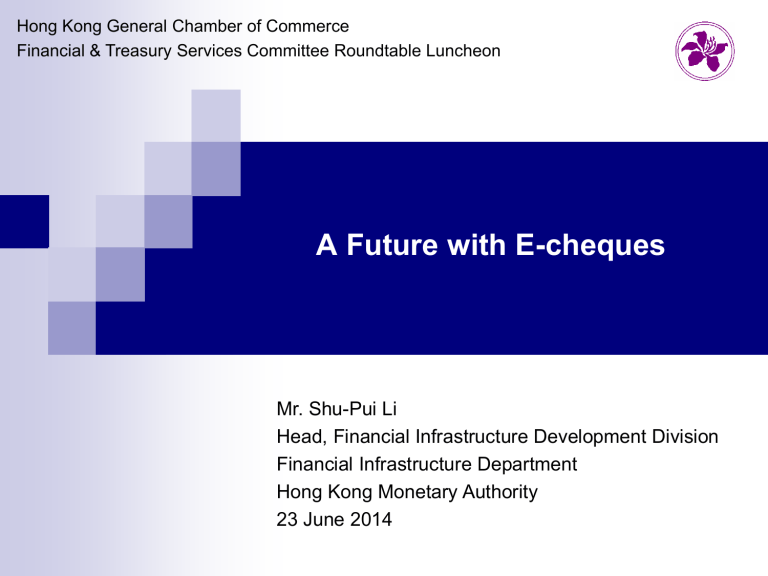
Hong Kong General Chamber of Commerce
Financial & Treasury Services Committee Roundtable Luncheon
A Future with E-cheques
Mr. Shu-Pui Li
Head, Financial Infrastructure Development Division
Financial Infrastructure Department
Hong Kong Monetary Authority
23 June 2014
2
Agenda
Introduction of e-cheque
Key drivers for the development of e-cheque
Nature and benefits of e-cheque
High-level operating model
Security features of e-cheque
Business cases for corporates to use e-cheque
2
Introduction of e-cheque
4
Need for an alternative of paper cheque
Resource intensive and costly for banks to process cheques
(Hong Kong banks need to spend up to HK$1.7 billion a year on processing cheque)
Increasing challenge for banks due to a wider usage of RMB cheques (e.g. for RMB IPO and RMB insurance policies)
Paper based meaning not environmental-friendly
Not convenient to use as it requires physical delivery and presentment
4
5
E-cheque
e-cheque: issued, delivered and presented electronically
Key features:
bill of exchange under the Bills of Exchange Ordinance (BOEO)
non-negotiable and non-transferable
digitally signed by payer and certified by payer’s bank
support HKD, USD and RMB denominated e-cheque
Target launch date: 2H 2015
5
Benefits of e-cheque
Retain all basic features and benefits of paper cheque and with the following additional benefits:
remove the need for physical delivery and presentment
carry enhanced security features
remove the costly and manual processing of paper cheque
6
Possible to expand to cross-border usage in the future
overseas residents with bank accounts in Hong Kong can easily issue and present e-cheque
Potentially cross-border cheque collection service can be facilitated by e-cheque
6
E-cheque Flow
(for banks which provide e-cheque issuance and presentment services on their own)
Payer
4B
Alternatively, payer can send e-cheque to payee via email (if payer wishes to send echeque to payee, probably together with other documents)
Digital signed e-cheque
Payee
4A
Send e-cheque to payee by payer’s bank by email
1 through
Internet
Banking or other authenticated means
Request for issuing e-cheque
3
Digital signed e-cheque
Digital signed e-cheque
Digital signed e-cheque
5
Present e-cheque through
Internet
Banking or other means
2 Create e-cheque
9
Verify signature, internal records and check for duplicate presentments
Payer’s Bank
8
HKICL
Inward clearing file and signed e-cheques
Clear and settle e-cheque
7
Outward clearing file and signed e-cheques
Payee’s Bank
6
Verify signature, payee identity and credit deposit
7
E-cheque Flow
(for banks which ride on HKICL’s centralized e-cheque presentment portal to provide presentment service to their customers)
Payer
4B
Alternatively, payer can send e-cheque to payee via email (if payer wishes to send echeque to payee, probably together with other documents)
Digital signed e-cheque
Payee
4A
Send e-cheque to payee by payer’s bank by email
1 through
Internet
Banking or other authenticated means
Request for issuing e-cheque
3
Digital signed e-cheque
Digital signed e-cheque
5
Present e-cheque and input payee’s bank details through centralized portal
2
Create e-cheque
10
Verify signature, internal records and check for duplicate presentments
Payer’s Bank
6
Verify signature
9
Inward clearing file and signed e-cheques
HKICL/
Centralized
Presentment portal
Clear and settle e-cheque
7
Outward clearing file and signed e-cheques
Payee’s Bank
8
Verify payee identity and credit deposit
8
9
Animated video and Prototype demo
Link to animated video
Link to prototype demo
9
Security measures
Virtual cheque book: Avoid unauthorized access to cheque books
2 factor authentication (2FA): Protect bank customers from internet banking fraud
Digital signature using PKI technology : Ensure the integrity of echeque
E-cheque issuance records: Allow payer bank to check the presented cheques against its own issuance records
Centralized presentment service: Guard against duplicate presentment
10
10
Use of PKI technology in e-cheque
E-cheque will be signed using the digital certificate issued by one of the recognized Certification Authorities
Two types of digital certificate can be used:
General purpose or personal digital certificate
Safe kept by the owner; can be used for all purposes
Special purpose digital certificate
Safe kept by payer’s bank; can be used for e-cheque and other banking services of that payer’s bank
11
11
Progress made
System development under way
Based on survey results, most retail banks have indicated interest to offer e-cheque service to their customers
Marketing campaigns will be organised closer to the service launch
Overall speaking, the project is progressing as planned
It is our target to launch the service in 2H 2015
12
12
Business cases for corporates to use e-cheque
Cost and benefit analysis for corporates to use e-cheque
Costs
Bank fees : based on our understanding, banks are not going to levy any fees for their customers to use e-cheques, except for bulk issuance which will also be less costly than that of paper cheques
Internal costs : Nil as corporates can easily issue and present echeques through internet banking platforms
Benefits
Easier to do reconciliation based on electronic records
Enhanced processing efficiency due to automation
Possible cost saving for bulk cheque issuance
14
The benefits of using e-cheque substantially outweigh its costs!
14
Case 1: Issuance of IPO refund cheques
Paper cheques E-cheques
From issuers’ perspective
Time needed to issue
IPO refund cheques
More time needed for cheque printing and mailing
Shorter time needed to issue e-cheques
15
Costs involved Processing, printing and mailing costs
Significant cost saving for using e-cheques (as there is no printing or mailing cost)
From IPO subscribers’ perspective
Time needed to receive
IPO refund cheques
1-2 days after refund day due to postal delay
Shorter time needed to receive e-cheques (i.e. likely for them to receive e-cheques on refund day)
15
Case 2: Collection of cheque payments
Paper cheques
From corporates’ perspective
Substantial efforts needed Efforts needed to do reconciliation (e.g.
checking against invoice amount and due date)
Presentment cut-off time
E-cheques
Minimal efforts needed
Cheques presented at or before 5pm on a business day will mostly be treated as same day clearing. Cheques presented after 5pm will be treated as next day clearing
Possible for banks to extend the presentment cut-off time to 7pm or 8pm, thus providing a longer window for e-cheque deposit for same day clearing and allowing corporates to receive good funds earlier
16
16


